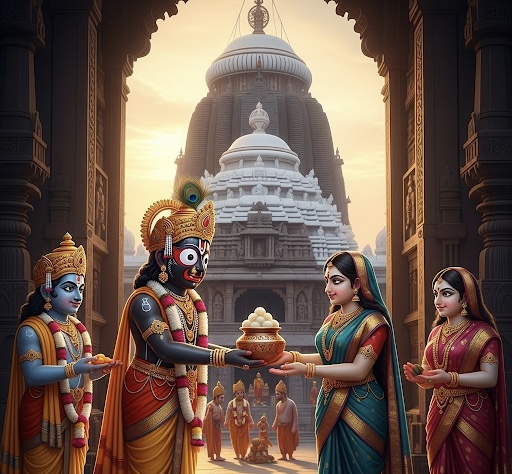The divine saga of Lord Jagannath of Puri is one of the most unique and living traditions in Hinduism. Among the many episodes associated with this deity, the story of how Lord Jagannath convinced Goddess Lakshmi after returning from His aunt’s house (Gundicha temple) stands out as both spiritually profound and culturally rich. Deeply embedded in the rituals of the famous Rath Yatra festival, this narrative is not merely mythological—it is an annual re-enactment of divine love, forgiveness, and reunion.
This article explores the detailed origin, symbolism, and historical context behind this fascinating story, revealing how a sacred episode from divine life is woven into the vibrant tapestry of Odisha’s living heritage.
The Mythological Backdrop: Rath Yatra and the Journey to Aunt’s House
Every year, in the month of Ashadha (June–July), the holy town of Puri in Odisha comes alive with the world-renowned Rath Yatra or Chariot Festival. During this grand occasion, Lord Jagannath, accompanied by His siblings Lord Balabhadra and Goddess Subhadra, leaves the sanctum of the Jagannath Temple and travels to the Gundicha Temple, believed to be the home of His aunt.
This journey, lasting for nine days, is not just a change of residence but a symbol of divine leela (cosmic play), love for devotees, and accessibility of the Lord beyond temple boundaries.
However, in this celestial episode lies an equally compelling subplot: the estrangement and eventual reconciliation between Lord Jagannath and Goddess Lakshmi, His divine consort.
The Cause of the Conflict: Lakshmi’s Displeasure
As per the Jagannath tradition, when the Lord leaves for the Gundicha Temple, He does so without taking Mahalakshmi along. This exclusion offends the goddess deeply. According to traditional Odia folklore, she feels humiliated and neglected, especially since she is the presiding deity of the main temple and the divine consort of Lord Jagannath.
In some versions of the tale, Lakshmi questions the propriety of the Lord’s decision to leave the palace-like temple and reside in the humble dwelling of His aunt, consuming simple food and staying in rustic surroundings. Others interpret her displeasure as a symbolic reference to the universal theme of neglecting duties towards one’s partner or responsibilities, even in the divine context.
As a result, Goddess Lakshmi locks the temple doors behind Him and refuses to allow Him re-entry upon His return.
Lakshmi’s Revenge: Hera Panchami Ritual
This divine drama reaches a climax on the fifth day of the Rath Yatra, known as Hera Panchami. On this day, Lakshmi Devi visits the Gundicha Temple in a beautifully decorated palanquin to confront her Lord. She does not enter the temple but stands outside and symbolically expresses her anger.
In this ritual, the goddess’s attendants even damage a portion of Lord Jagannath’s chariot, symbolizing her displeasure. This act, while metaphorical, represents the assertiveness and strength of the divine feminine and the emotional depth of the divine relationship.
After expressing her protest, Lakshmi returns quietly to the main temple via a secret path called “Lakshmi Bije”, preserving her dignity and power.
The Reconciliation: Convincing Lakshmi
After the conclusion of the Rath Yatra and upon Lord Jagannath’s return to the main temple, a ceremonial and affectionate reconciliation is enacted. This ritual is known as “Niladri Bijay”—literally meaning “Return to Nilachal (Blue Mountain),” the abode of Lord Jagannath.
As the Lord approaches the temple, the doors are still closed—Lakshmi has not forgiven Him yet. What follows is a tender and symbolic exchange of divine persuasion, where the Lord expresses repentance, offers gifts, and seeks to appease the goddess.
The central part of this reconciliation is the offering of Rasagola (a soft, syrupy sweet) by Lord Jagannath to Lakshmi. According to Odia tradition, this act represents both a sweet apology and a loving gesture. Only after Lakshmi is appeased does she allow the Lord back into the sanctum sanctorum.
This moment is celebrated with immense joy and fanfare by devotees, for it is not just the return of the Lord but the restoration of divine harmony.
Origin of the Ritual and Cultural Roots
The story of Lord Jagannath convincing Lakshmi is not found in the canonical Vedas or Puranas, but in regional Odia scriptures, temple traditions, and oral literature. It reflects the highly anthropomorphic and relatable nature of Jagannath culture, where gods and goddesses are portrayed with human emotions and familial dynamics.
This tradition finds its roots in Vaishnavism, particularly in the Panchasakha literature and works like the “Jagannath Mahatmya” and local legends preserved by the daityapatis (temple servitors) and pandas (priests). Over centuries, the tradition evolved, drawing influences from tribal beliefs, Tantric rituals, and bhakti poetry, creating a unique blend of divine devotion and folk culture.
The offering of Rasagola has led to the celebration of “Rasagola Dibasa” (Rasagola Day) in Odisha, particularly since 2015, as a cultural assertion of Odia heritage and Jagannath tradition.
Symbolism and Deeper Meaning
This divine tale is rich in symbolic meaning:
- Reconciliation in Relationships: The story teaches the value of seeking forgiveness, reconciliation, and mutual respect in relationships—whether divine or human.
- Balance Between Masculine and Feminine: The refusal of Lakshmi to blindly accept the Lord’s behavior and her eventual forgiveness underscores the strength and equality of the divine feminine.
- Bhakti and Leela: Jagannath’s life is filled with leelas (divine plays) that make the Lord accessible to all. This episode reflects the emotional and devotional connection between god and devotee.
- Cultural Unity: The entire episode, from Hera Panchami to Niladri Bijay, is enacted by servitors from various castes and communities, demonstrating Odisha’s inclusive religious ethos.
Legacy and Modern Celebration
Today, the reenactment of these events is a core part of the Rath Yatra celebrations. The temple rituals, accompanied by traditional music, dance, and storytelling, bring the myth alive every year for millions of devotees.
The tale also resonates widely in contemporary times—highlighting themes of emotional intelligence, responsibility, and the importance of making amends in personal and spiritual life.
In an age of fleeting relationships and mechanical rituals, the heartfelt tale of Lord Jagannath and Lakshmi reminds us that divine love too, like human love, requires attention, understanding, and occasional sweet reconciliation.
Conclusion
The story of how Lord Jagannath convinced Lakshmi after returning from His aunt’s house is more than just a charming myth—it is a deeply spiritual and symbolic episode that continues to shape the religious consciousness of Odisha and Jagannath devotees worldwide. With layers of cultural, emotional, and philosophical meaning, it is a celebration of divine love, feminine strength, and the enduring beauty of forgiveness.
As chariots roll every year through the streets of Puri, this timeless narrative lives on—reaffirming faith, reviving traditions, and reminding us that even gods must sometimes earn forgiveness with humility and a handful of sweets.


